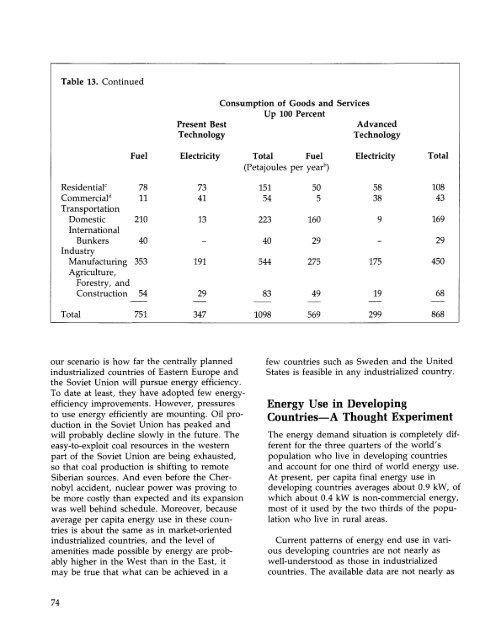ENERGY FOR A SUSTAINABLE WORLD - World Resources Institute
ENERGY FOR A SUSTAINABLE WORLD - World Resources Institute
ENERGY FOR A SUSTAINABLE WORLD - World Resources Institute
Create successful ePaper yourself
Turn your PDF publications into a flip-book with our unique Google optimized e-Paper software.
Table 13. Continued<br />
Consumption of Goods and<br />
Up 100 Percent<br />
Present Best<br />
Technology<br />
Services<br />
Advanced<br />
Technology<br />
Fuel<br />
Electricity<br />
Total<br />
(Petajoules<br />
Fuel<br />
per year b )<br />
Electricity<br />
Total<br />
Residential 0<br />
Commercial 11<br />
Transportation<br />
Domestic<br />
International<br />
Bunkers<br />
Industry<br />
Manufacturing<br />
Agriculture,<br />
Forestry, and<br />
Construction<br />
78<br />
11<br />
210<br />
40<br />
353<br />
54<br />
73<br />
41<br />
13<br />
_<br />
191<br />
29<br />
151<br />
54<br />
223<br />
40<br />
544<br />
83<br />
50<br />
5<br />
160<br />
29<br />
275<br />
49<br />
58<br />
38<br />
9<br />
-<br />
175<br />
19<br />
108<br />
43<br />
169<br />
29<br />
450<br />
68<br />
Total<br />
751<br />
347<br />
1098<br />
569<br />
299<br />
868<br />
our scenario is how far the centrally planned<br />
industrialized countries of Eastern Europe and<br />
the Soviet Union will pursue energy efficiency.<br />
To date at least, they have adopted few energyefficiency<br />
improvements. However, pressures<br />
to use energy efficiently are mounting. Oil production<br />
in the Soviet Union has peaked and<br />
will probably decline slowly in the future. The<br />
easy-to-exploit coal resources in the western<br />
part of the Soviet Union are being exhausted,<br />
so that coal production is shifting to remote<br />
Siberian sources. And even before the Chernobyl<br />
accident, nuclear power was proving to<br />
be more costly than expected and its expansion<br />
was well behind schedule. Moreover, because<br />
average per capita energy use in these countries<br />
is about the same as in market-oriented<br />
industrialized countries, and the level of<br />
amenities made possible by energy are probably<br />
higher in the West than in the East, it<br />
may be true that what can be achieved in a<br />
few countries such as Sweden and the United<br />
States is feasible in any industrialized country.<br />
Energy Use in Developing<br />
Countries—A Thought Experiment<br />
The energy demand situation is completely different<br />
for the three quarters of the world's<br />
population who live in developing countries<br />
and account for one third of world energy use.<br />
At present, per capita final energy use in<br />
developing countries averages about 0.9 kW, of<br />
which about 0.4 kW is non-commercial energy,<br />
most of it used by the two thirds of the population<br />
who live in rural areas.<br />
Current patterns of energy end use in various<br />
developing countries are not nearly as<br />
well-understood as those in industrialized<br />
countries. The available data are not nearly as<br />
74

















